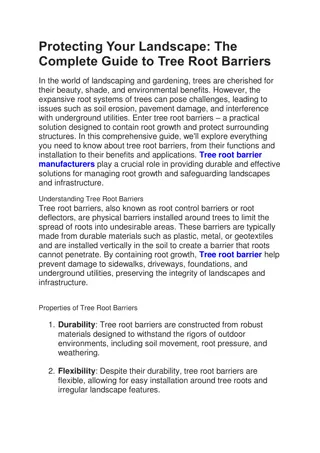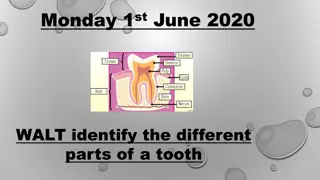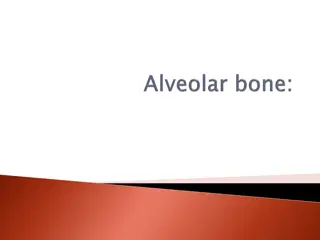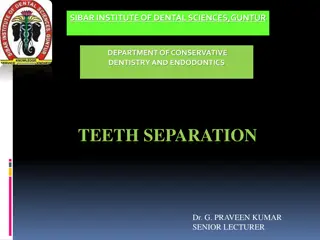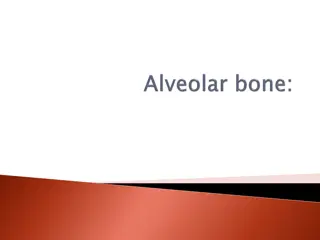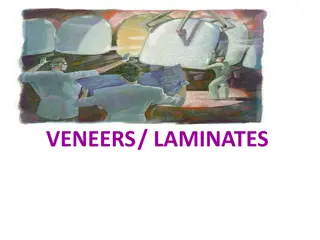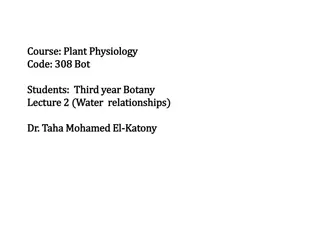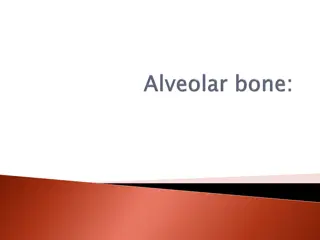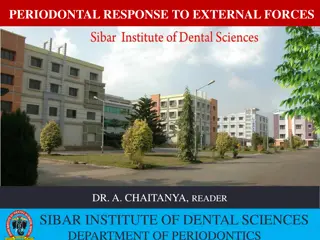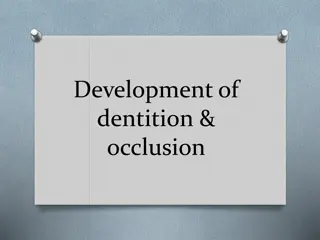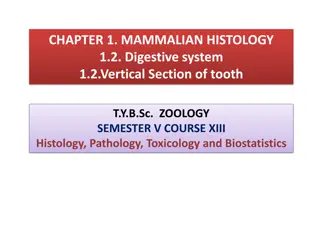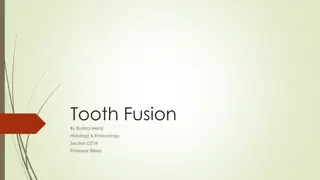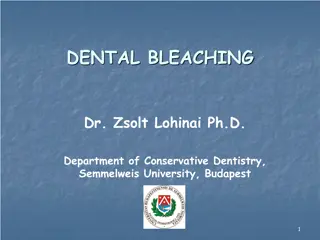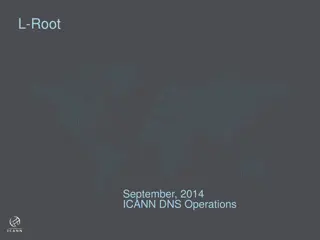Root Development in Tooth Growth Process
Root formation plays a crucial role in the development of teeth, starting after enamel and dentin formation at the cementoenamel junction. Hertwig's epithelial root sheath (HERS) molds the shape of roots, initiating radicular dentin formation. The cervical loop forms an epithelial diaphragm, narrowing the wide cervical opening of the tooth germ. Mesenchymal cells in the dental pulp are induced to form odontoblasts by inner epithelial cells, leading to the formation of root dentin. The process involves the proliferation of various tissues and cells, ultimately resulting in the completion of root development.
- Tooth development
- Root formation
- Hertwigs epithelial root sheath
- Odontoblast differentiation
- Dental pulp
Download Presentation

Please find below an Image/Link to download the presentation.
The content on the website is provided AS IS for your information and personal use only. It may not be sold, licensed, or shared on other websites without obtaining consent from the author. Download presentation by click this link. If you encounter any issues during the download, it is possible that the publisher has removed the file from their server.
E N D
Presentation Transcript
Lec. Lec. 12 12 Root formation Root formation Sura Haddad Msc in Histology Collage of Dentistry ,University of Basrah Department of Oral Diagnosis
After enamel and dentin formation reached to the future cementoenamel junction the development of roots begin. The enamel organ are very important part in this stage of root development by forming Hertwig s epithelial root sheath in cervical loop The HERS molds the shape of the roots and initiates radicular dentin formation. Hertwig s epithelial root sheath consist from the outer and inner enamel epithelia only.
Before the starting of root formation the cervical loop forms the epithelium diaphragm In the future cementoenamel junction the cervical loop bend into a horizontal plane and form the epithelial diaphragm This diaphragm narrowing the wide cervical opening of the tooth germ. The plane of the diaphragm remains relatively fixed within the development and growth of the root. At the same time the proliferation of the cells of the epithelial diaphragm is accompanied by proliferation of the C.T. of the pulp.in the area adjacent to the diaphragm.
After form the HERS the undifferentiated mesenchymal cells in the dental pulp induction by the inner epithelial cells to form odontoblast to formation the root dentin The differentiation of odontoblasts and the formation of dentin follow the lengthening of the root sheath. At the same time the C.T. of the dental follicale surrounding the root sheath proliferates and invades the continuous double epithelial layer (Hertwig s epithelial root sheath)and dividing it into a network of epithelial strands. Then the epithelium is moved away from the surface of the dentin so that C.T. cells come into contact with the outer surface of the dentin of the root and differentiate into cementoblast which deposit a layer of cementum onto the surface of the root dentin.
in the last stage of root development the proliferation of the epithelium in the diaphragm lags behind that of the pulpal C.T. The wide apical foramen is reduced the width of the diaphragmatic opening itself. Later is further narrowed by apposition of dentin and cementum to the apex of the root.
Formation of multi Formation of multi- -root root When the Hertwig s epithelial root sheath formed from a double layer of inner and outer enamel epithelium This sheath grows around the dental papilla between the dental papilla and dental follicle. Differential growth of the epithelial diaphragm in multi rooted teeth causes the division of the trunk into 2or 3 roots. Two tongues like extension of the horizontal diaphragm develop in teeth with2roots and 3 tongues like extension develop in teeth with 3 roots.
The free ends of these horizontal epithelial flaps grow toward each other and fuse. The pulpal surface of the dividing epithelial bridges, dentin formation and on the periphery of each opening The root sheath determines whether a tooth has single or multiple roots , short or long and curved or straight.
Single root formation: Single root formation: The root sheath grows like cuff or tube around the newly forming pulp. Development of multi- rooted teeth takes place in a same manner until the furcation area. When the furcation area is reached the epithelial diaphragm develops tongue like extensions that grow.
Fate of epithelial root sheath: Fate of epithelial root sheath: After dentin formation in root takes place, the epithelial root sheath breaks down and its remnants migrate away from the dentinal surface They lie in the periodontal ligament and called epithelial rests of Malassez The epithelial rests of Malassez are found in the periodontal ligament through out the life When there is chronic inflammation the epithelial cell rest of Malassez proliferate into cysts and tumours
Root formation anomalies: Root formation anomalies: If the continuity of the root sheath is broken before the dentin is formed it result in missing or abnormal epithelial cells. When the epithelial cells are missing the odontoblasts do not differentiate and dentin doesn t form opposite the defect that occurred in the root sheath The result will be a small lateral canal ,this lateral canal called accessory canal Accessory canals connect the main root canal with the periodontal ligament they contact each
If the epithelial root sheath does not degenerate at the proper time and remain stuck to the surface of the root dentin then that area becomes devoid of cementum. The area of root without cementum can be a cause of sensitivity if there is gingival recession



